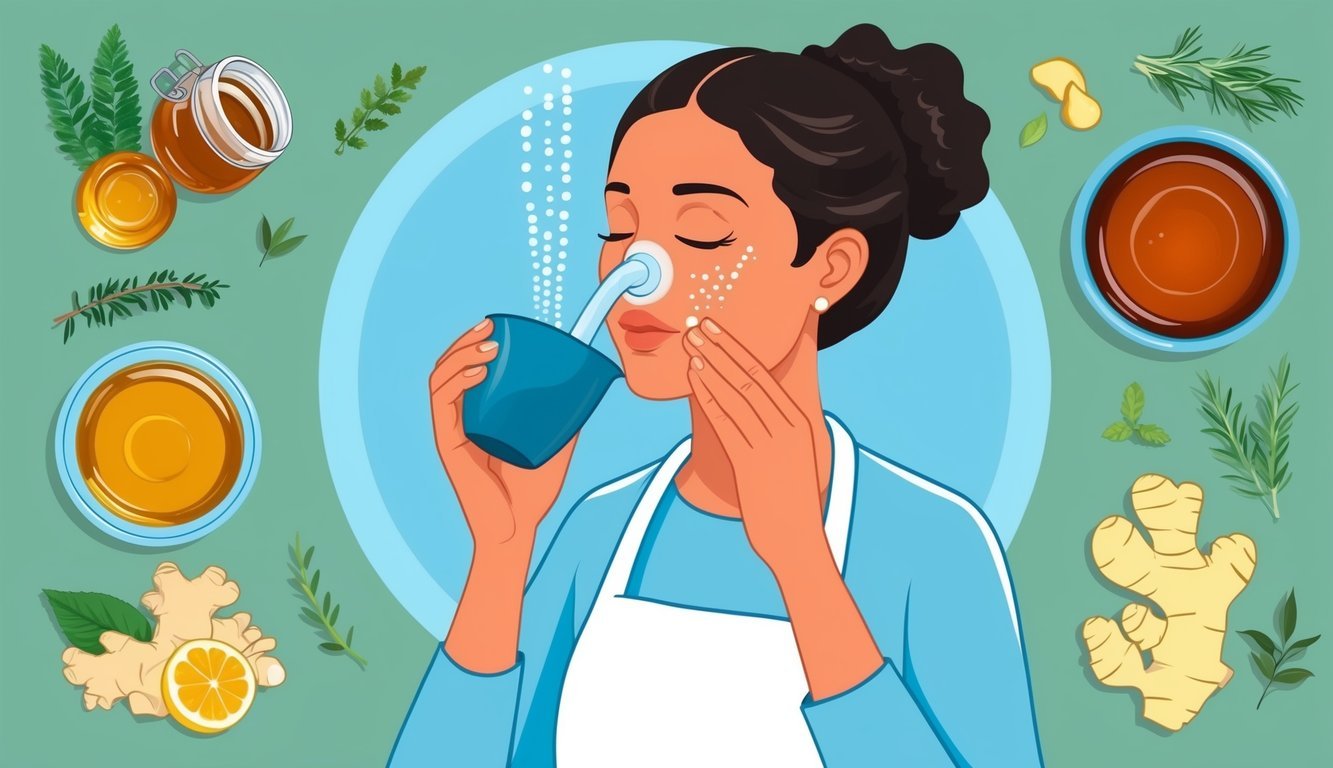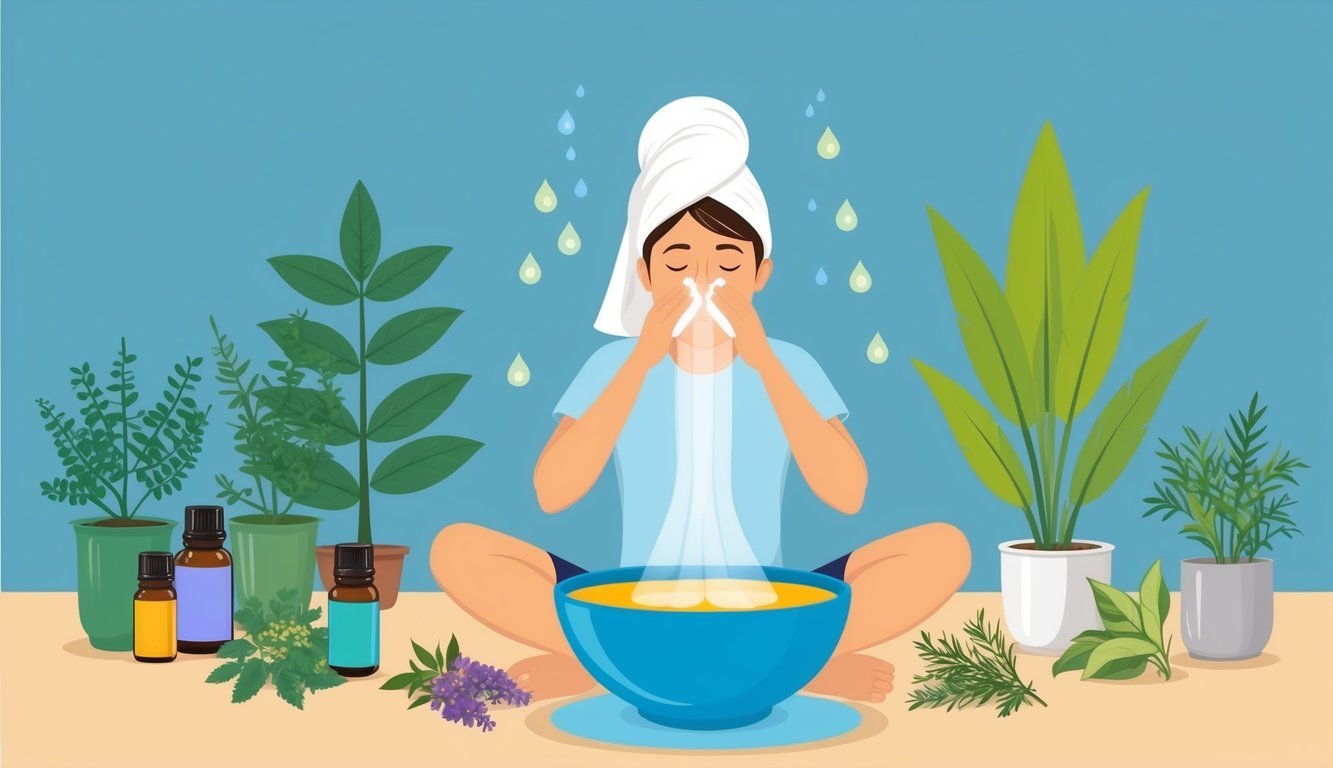Allergies can really throw a wrench in my day-to-day life.
Whether it’s pollen in the spring or dust mites year-round, I’m always on the lookout for effective ways to ease my symptoms without relying solely on medication. I’ve found plenty of natural remedies that can help manage allergic reactions, offering relief without the side effects that sometimes come with pharmaceuticals.

I’ve explored different options that fit seamlessly into my routine, making it easier to cope when allergens strike.
From household ingredients to simple lifestyle changes, I found that these approaches not only help me feel better but also empower me to take control of my health.
1) Use a saline nasal spray
A saline nasal spray has been a game changer for me when dealing with allergy symptoms.
It’s simple and effective.
The saline solution helps to rinse out allergens and mucus from my nasal passages.
I usually spray it into each nostril a few times a day, especially when I feel stuffy.
It’s great for breaking up the mucus and opening up my sinuses so I can breathe easier.
Applying a saline spray is safe and doesn’t come with the side effects that some medicated sprays might have.
I’ve found that it’s particularly useful after being outside, where allergens like pollen can really flare up my symptoms.
When purchasing, I choose a non-medicated option from the drugstore.
It’s easy to use, and I always feel a bit relieved afterward.
Keeping my nasal passages clear has made a noticeable difference in how I handle allergy season.
2) Try local honey
I’ve found that local honey can be an interesting option for managing allergy symptoms.
The idea is that consuming honey made from local pollens might help me build immunity to the allergens in my environment.
When I use local honey, I appreciate its natural enzymes and antioxidants.
Unlike processed honey, local varieties retain many beneficial properties that might support my overall health.
While some people swear by this method, scientific evidence is limited.
I’ve read opinions from experts suggesting that honey may offer some soothing properties, but it isn’t a guaranteed solution for allergies.
Still, incorporating local honey into my diet feels like a low-risk approach.
Just a spoonful in my tea or on toast can be a tasty addition to my routine.
I make sure to avoid giving honey to infants under one year old, as it poses some risks for them.
Overall, trying local honey could be a delightful and simple way to support my allergy management efforts.
3) Eat Omega-3 Rich Foods
In my journey to manage allergy symptoms naturally, I found that eating foods high in omega-3 fatty acids can make a difference.
Omega-3s are known for their anti-inflammatory properties, which can be helpful during allergy season.
Fatty fish like mackerel, salmon, and sardines are among the best sources.
Just a few servings each week can help support my immune system.
I try to include these fish in my meals regularly.
If I’m looking for plant-based options, I turn to chia seeds, flaxseeds, and walnuts.
These foods are packed with omega-3s and can easily be added to smoothies or salads for a nutrient boost.
Even foods like wild rice offer some omega-3s and are a great addition to my diet.
Incorporating these foods not only helps reduce inflammation but also promotes overall wellness.
Keeping my diet balanced with omega-3-rich options makes me feel more prepared to tackle allergy challenges.
4) Incorporate quercetin-rich foods

Adding quercetin-rich foods to my diet can really help with allergy symptoms.
Quercetin is a natural antioxidant that acts as an antihistamine, which makes it useful during allergy season.
Foods like onions, apples, and peppers are some of my favorites.
I often include these in salads or as snacks to boost my intake.
Cherry tomatoes are particularly good because they have a high quercetin content and are great for snacking.
Citrus fruits like grapefruit also pack a punch with quercetin.
I love mixing them into smoothies for a refreshing drink.
Eating a variety of colorful fruits and vegetables not only helps with allergies but also enhances overall health.
When I make sure to get enough quercetin, my body feels more equipped to handle seasonal changes.
Incorporating these foods into my meals has become a simple and effective way to manage my allergies naturally.
5) Drink green tea

I’ve found that drinking green tea can really help with allergy symptoms.
It’s packed with antioxidants, which support my immune system.
When I drink green tea, I love knowing it contains quercetin, a natural antihistamine.
Quercetin works by stabilizing the release of histamines, which can lead to fewer allergy flare-ups for me.
I usually brew a cup or two, especially during allergy season.
Sipping it consistently can make a noticeable difference in how I feel.
Also, green tea is versatile.
I can enjoy it hot or iced, depending on my mood.
It’s a simple addition to my routine that makes managing allergies a bit easier.
6) Use a neti pot

I’ve found that using a neti pot can really help tackle allergy symptoms.
This simple tool allows me to rinse out my nasal passages with a saline solution.
To get started, I mix warm, sterile water with salt.
It’s important to use distilled or boiled water to avoid any bacteria.
After preparing the solution, I tilt my head and let the saline flow through one nostril and out the other.
This process helps to flush out allergens and mucus.
I usually feel immediate relief after a session.
It’s such an effective way to clear my sinuses and breathe easier.
Just a few minutes can make a difference.
Regular use, especially during allergy seasons, can keep my nasal passages clear.
It’s become a routine I rely on during peak allergy times.
7) Steam inhalation

I’ve found steam inhalation to be a simple yet effective way to ease allergy symptoms.
When I inhale steam, it helps clear out mucus in my nasal passages and throat, making it easier to breathe.
I often use a hot shower or a bowl of hot water for this.
Just leaning over the bowl with a towel draped over my head traps the steam, allowing me to inhale it deeply.
This method not only helps with mucus but also keeps my throat moist, easing irritation.
On days when my allergies flare up, this quick fix becomes essential for relief.
Just a word of caution: a few people I know find heat to aggravate their symptoms.
I always listen to my body—if it feels uncomfortable, I stop.
For me, steam inhalation is a go-to remedy.
It’s natural, easy to do, and can really provide a break from congestion.
Understanding Allergies

Allergies occur when the immune system mistakenly identifies a harmless substance as a threat.
This can lead to various symptoms that can be uncomfortable or even serious.
I’ll explain what happens during an allergic reaction and the common triggers involved.
What Happens During An Allergic Reaction
When I come into contact with an allergen, my immune system responds by producing antibodies called immunoglobulin E (IgE).
These antibodies trigger the release of chemicals, including histamine, which is responsible for many allergy symptoms.
During this process, I might experience sneezing, itching, or swelling, as histamine acts on tissues.
The severity of the reaction can vary from mild irritation to anaphylaxis, a potentially life-threatening condition.
My body’s response can depend on factors like the type of allergen and my previous exposure.
Unlike common colds, allergy symptoms can linger until the allergen is eliminated.
Common Triggers
There are numerous allergens that I might encounter in daily life.
Here are some of the most common triggers:
- Pollen: Released by trees, grasses, and weeds, this is a major seasonal irritant.
- Dust Mites: These tiny creatures thrive in bedding and upholstery, triggering reactions for many.
- Mold: Fungus that can grow indoors or outdoors; it loves damp environments.
- Pet Dander: Skin flakes from pets can cause symptoms for those with sensitivities.
- Food: Common allergens include nuts, dairy, and shellfish; reactions can be serious.
Knowing my triggers helps me manage my symptoms better.
Natural Remedies and Lifestyle Changes

In my journey to manage allergies, I’ve found that dietary modifications and mind-body techniques can make a significant difference.
These approaches not only help alleviate symptoms but also promote overall wellness.
Dietary Adjustments
I’ve learned that what I eat can heavily influence my allergy symptoms.
Incorporating specific foods, such as foods rich in Vitamin C, can provide natural antihistamine effects.
Fruits like oranges, strawberries, and kiwis are great choices.
Another beneficial addition is quercetin.
This antioxidant stabilizes histamine release and can be found in foods like onions, apples, and green tea.
Staying hydrated is crucial too.
Drinking plenty of water helps thin mucus and keep airways clear.
Avoiding common allergens like dairy or gluten might also reduce inflammation and improve my overall response to allergens.
Mind-Body Techniques
Incorporating mind-body techniques has significantly helped me manage stress and improve my allergy symptoms.
Practices like yoga and meditation create a calming environment that can reduce overall sensitivity to allergens.
When I take time to practice deep breathing exercises, it not only calms my mind but also helps clear my airways, making it easier to breathe.
This simple practice enhances my focus and endurance, especially during physical activities.
By incorporating the best breathing techniques for workouts, I can optimize oxygen flow to my muscles, reducing fatigue and improving performance.
Over time, these techniques have become an essential part of both my fitness routine and overall well-being.
Additionally, regular exercise boosts my immune system and can assist in reducing the severity of allergic reactions.
Activities like walking or swimming are excellent low-impact options that I enjoy.
These dietary adjustments and mind-body practices form a holistic approach that has been effective in managing my allergies.

